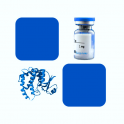
- Remove this product from my favorite's list.
- Add this product to my list of favorites.
Products
Newsletter
 |  |  |  |  |  |

Background
Nucleocapsid (N) protein is the most abundant protein found in coronavirus. CoV N protein is a highly immunogenic phosphoprotein important for viral genome replication and modulation of cell signaling pathways. It was first identified by a research team while they were screening for ADP-ribosylated proteins during coronavirus (CoV) infection (Grunewald M. E., et al. 2017, Virology; 517: 62-68). The array of diverse functional activities accommodated in N protein makes it more than a structural protein but also an interesting target in the development of antiviral therapeutics. Because of the conservation of N protein sequence and its strong immunogenicity, N protein of coronavirus is chosen as a diagnostic tool.
Source
Recombinant SARS-CoV-2 Nucleocapsid protein (R203K, G204R), His Tag (NUN-C52Hg) is expressed from human 293 cells (HEK293). It contains AA Met 1 - Ala 419 (Accession # QHO62115.1 (R203K, G204R)). The nucleocapsid protein is consisted of the N-terminal RNA-binding domain (NTD) and the C-terminal dimerization domain (CTD), divided by a central serine/arginine-rich (SR)-linker responsible for phosphorylation. The mutations (R203K, G204R) were identified on the SR-linker on the nucleocapsid protein of SARS-CoV-2 variants. Phosphorylation of this SR-link motif in SARS-CoV modulates nucleocapsid multimerization, translational inhibitory activity and cellular localization. The co-occuring mutations R203K and G204R may decrease the overall structural flexibility of SARS-COV-2 N protein.
Predicted N-terminus: Met 1
Molecular Characterization
This protein carries a polyhistidine tag at the C-terminus.
The protein has a calculated MW of 47.4 kDa. The protein migrates as 55-65 kDa under reducing (R) condition (SDS-PAGE) due to glycosylation.
Endotoxin
Less than 1.0 EU per μg by the LAL method.
Purity
>90% as determined by SDS-PAGE.
Formulation
Lyophilized from 0.22 μm filtered solution in PBS, pH7.4. Normally trehalose is added as protectant before lyophilization.
Reconstitution
Please see Certificate of Analysis for specific instructions.
For best performance, we strongly recommend you to follow the reconstitution protocol provided in the CoA.
Storage
For long term storage, the product should be stored at lyophilized state at -20°C or lower.
Please avoid repeated freeze-thaw cycles.
This product is stable after storage at:
-20°C to -70°C for 12 months in lyophilized state;
-70°C for 3 months under sterile conditions after reconstitution.
Bioactivity
Please refer to product data sheet.
(1) "Liquid-liquid phase separation of nucleocapsid proteins during SARS-CoV-2 and HIV-1 replication"
Chau, Chen, Cochrane et al
Cell Rep (2022) 42 (1), 111968
(2) "Reactivity of NiII, PdII and PtII complexes bearing phosphine ligands towards ZnII displacement and hydrolysis in Cis2His2 and Cis3His zinc-fingers domains"
Galuppo, Gomes de Oliveira Junior, Dos Santos Oliveira et al
J Inorg Biochem (2022)
(3) "Proteomic screening identifies RPLp2 as a specific regulator for the translation of coronavirus"
Dong, Wang, Zhang et al
Int J Biol Macromol (2023) 230, 123191
Showing 1-3 of 53609 papers.
Recombinant SARS-CoV-2 (COVID-19) S1 protein, His Tag (MALS verified), 100µg - 494,00 €
Recombinant Biotinylated SARS-CoV-2 (COVID-19) S1 protein, His,Avitag™ (MALS verified), 25µg - 494,00 €
Recombinant SARS-CoV-2 (COVID-19) S protein RBD, Fc Tag (MALS verified),100µg - 494,00 €
Recombinant SARS-CoV-2 (COVID-19) Nucleocapsid protein, His Tag, 100µg - 520,00 €
Welcome Login
Contact us
Follow us